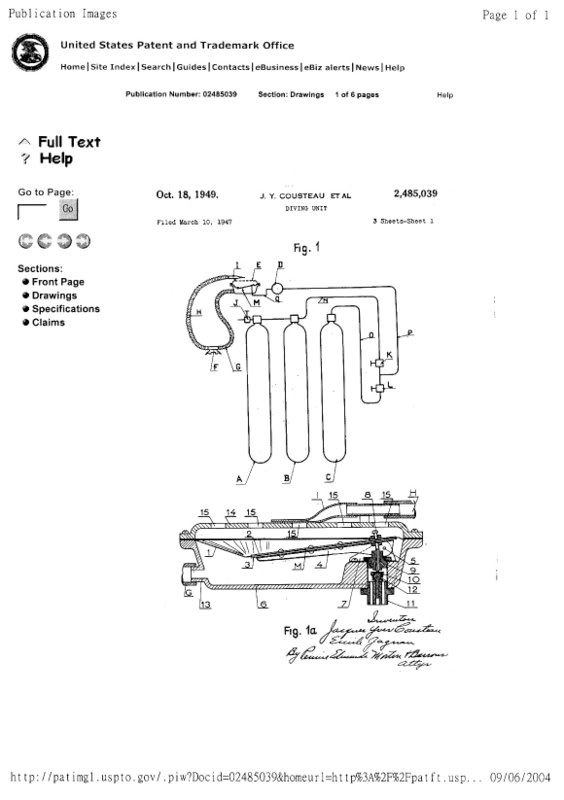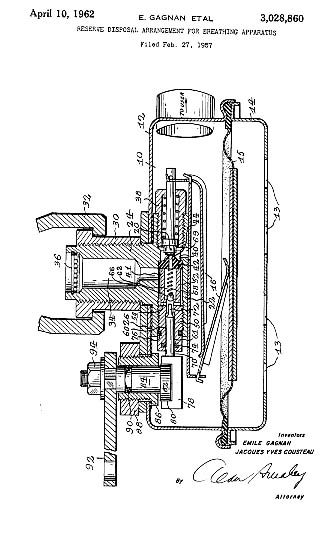Here is the drawing from the original Cousteau-Gagnan patent from 1949 (USA).
Also, here is a patent for Gagnan-Cousteau (reversal of names) for a single stage, downstream valve regulator which looks a lot like the AMF Voit 50 Fathom.
SeaRat
I have just been reading the patent, and the text is very interesting. If you will look at Fig. 1, you will see in the upper left area that there are actually two regulators, or reducing valves, on the original Cousteau patent. The first is designated "D," and is a regulator which reduces the pressure from tank pressure to an interstage pressure. Gagnan, in the text, states:
...The regulator shown in Fig. 1a is of the same type as that described in Swiss Patent No. 234,418 granted on the invention of one of the inventors of the present diving unit, but it might as well be of any other conventional type, inasmuch as the mechanism through which the deflection of the resilient diaphragm controls the opening of the valve member is quite immaterial in the present invention...
In other words, this is a Gagnan single stage regulator in line with a second demand regulator, which also is a single stage regulator. This makes sense if you look at the original black and white photos of Dumas diving the original three-tank Aqualung as shown in
The Silent World (the book, not the movie). There are many, almost a tangle, of lines and hoses on that system. So from what I can tell, the original open circuit scuba by Cousteau-Gagnan was two single stage regulators in line. This is corroborated by the patent description itself:
While two one-stage pressure regulators D and E have been shown, they may, if desired, be replaced in known manner by one two-stage regulator.
Such a regulator is shown in Figs. 4 to 11...
The patent then shows a diagram, Figures 4 to 11, which is the exact diagrams of the CG-45 and the DA Aqualung.
What this tells me is that Gagnan took his original regulator, and built onto it a second single-stage regulator which operated on an interstage pressure:
The air which has passed through one of the cocks, K or L, as the case may be, flows through the pipe P and thence through a first pressure-reducing valve or regulator D, which delivers it under a predetermined pressure of a few, for instance two, kilograms per square centimeter in excess of that of the surrounding media. The air then flows through pipe Q to a second pressure regulator shown generally at E, and on a larger scale in cross section in Fig. 1a.
The description of how the second regulator operates is in the patent too. But the above description leads to the question of how much air they were able to get through this rig, when the interstage pressure appears to be only about 30 psig. This may be why they went so quickly to the CG-45 and DA Aqualung.
There are other tidbits, as for instance the use of cylinders
designed that when the cylinders are empty it has an apparent weight in water which is nill, whether it be in river water or sea water, etc. The weight of the breathable gas which fills the cylinders is compensated for, for example, by releasable floats which may be secured to the belt of a diver and which are released by him one by one as he consumes breathable gas, so as to maintain buoyancy as near to zero as possible. The buoyancy of the diver himself, which is dependent on his breathing capacity and which is about 2 to 3 kgs., is compensated for by a single releasable lead weight, which also may be secured to the belt and designated "safety lead."
There's even more, but you get the idea. I can envision Cousteau and Dumas on their trial dives saying "Wow, these cylinders are heavy; we need some buoyancy to throw away during the dive as the air pressure lessens and we gain buoyancy." After all, they were diving three super-long tanks.
SeaRat






